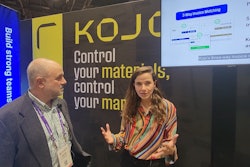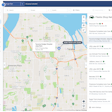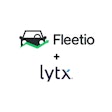
Slick and efficient tools for mechanical contractors and others servicing and maintaining assets in the field combined with an aggressive channel sales approach give Nashville, Tenn.-based XOI Technologies a solid tactical position to add new customers intent on increasing efficiency in the field giving technicians advanced tools that automate tasks, improve outcomes and create new revenue opportunities.
XOI is not competing directly with field service management software vendors that offer transactional systems to construction and the trades. Rather, they are partnering with companies like ServiceTitan, FieldConnect, Operix, Jonas Construction Software, Key2ACT, Penta Technologies and Microsoft Dynamics.
This means XOI’s tool set can be broadly adopted, their main competition being the mobile interface of whatever software they are partnering with. Standalone applications may also duplicate some of what XOi can deliver, including the Blitzz video inspection and support application. Field service management software products like Sage Field Operations, Workwave and ServiceTitan that handle the business transaction side of service can give way at the point of service to XOI’s product set which includes:
- The XOI Journeyman Platform which includes OCR to pull asset data from an equipment dataplate including make/model, manufacturer, model number and serial number.
- Journeyman Insights, which surfaces data on which customers have hardware or equipment that is nearing end of life. These replacement opportunities mean revenue that otherwise could be missed, and happy customers that could be adversely affected by failures without proactive service.
- XOI Vision, a video communication center that enables technicians, back-office experts and customers to capture images, receive coaching or collaborate with each other to streamline project communications.
By extending and adding value to other solutions, XOI is also in a position to efficiently get to market. The company at the time of our debriefing process in October of 2022, the company had just more than 80 employees. Given the tight focus of the XOI solution, the research and development team of 40 should be fairly adequate, and a sales force of 15 left the remaining complement of employees focused on customer success, which should be heartening to potential buyers. While the addressable market for XOI is huge, the sales team likely will not need to grow much according to XOI Founder and CEO Aaron Salow. This is because XOI is often in a position to ride into contracting businesses through the broader field service or operations application partners.
“We work very deeply with our channel relationships,” Salow said. “We will likely never have 200 salespeople. Our technology is very much focused on the job site. We have 30-plus integrations between XOI, Service Titan and others. So we highly value these channel relationships.”
XOI also has established a channel relationship with DKD Agency, a global field service management company and NetSuite Partner for NetSuite Customers. Overall, about 65% of XOI’s new customers come through the channel, which means these point-of-service toolsets could quickly come to address a larger swath of the market, particularly as the number of integrations with other applications, including Procore, continues to grow.
Technology and product
The XOi code line comprises a serverless architecture on multiple availability zones on Amazon Web Services. The application is Soc2 Type 2 compliant, which is important for some of the larger enterprise organizations XOi serves, including McDonald Miller, Havtech, Comfort Systems, EMCOR, and Trane.
The tech stack has evolved from one focused on wearables to the current set of cloud functionality that can harness the feature set of a mobile device. The Visionapp harnesses machine learning to simplify the identification and sharing of photos and videos captured in the field. The app surfaces workflows created for or adopted by the company for technicians to follow, including rich features supported by the smartphone or device.
The company started with a focus on wearables, launching the XOne smart glass product in 2014 with firmware that presented a technician a stream of data on customer status, technical support through augmented reality. Simultaneously, the wearable could capture a data stream that may comprise video of what the technician is seeing to drive video support and troubleshooting or bar codes. By 2017, they were partnering with other wearables companies, including Vuzix.
By 2018, they were more mobile device-focused, and began to lay out their current functionality set of customizable workflows, service ticketing, a product knowledge base and video support and collaboration.
“We learned some valuable lessons putting thousands of smart glasses into field service,” Salow said. “We learned this curb-to-curb space at the job site is significantly under communicated, underserved and we had an opportunity for providing value. We were not trying to be a field service management solution running ticketing and dispatch, inventory, labor and all the things an FSM will do—the IFS, the Servicemax. But we realized about five years ago there was an opportunity to do not just live video, but if we could get our solution on mobile phones and tablets, we could pivot and provide an instructional and collective tool for technicians on a jobsite. We hope the technician will be able to learn, have contextual intelligence in the time of need when they have a problem,
Service lifecycle and asset lifecycle management
The combined OCR and machine vision elements of the product though are not to be underestimated, and it is here a lot of the measurable process and productivity improvements are created. Automating and facilitating an engaged field service technician’s activities creates a wealth of data about the asset reliably enough and completely enough to contribute to an as-built or as-maintained digital twin of the asset. While Salow may talk more about the value of how these insights can be extended across others, the high-quality structured data has value that also ought to be mined. And this level of data quality for the back office and the asset managers will be harder to achieve without real automation for the technician at the tip of the spear.
Manufacturers of equipment assets also have a role to play, and inclusion of data from them helps XOi contractors/users and manufacturers deliver a better user experience. One challenge faced by any manufacturer of building systems, materials or components is that improper application, installation, startup or maintenance affects asset life and owner experiences.
“When the technician takes photo of a data plate, they get the right OEM information, manuals, line diagrams, relevant visual content, the most active service bulletins,” Salow said. “If all that does not help, we’re giving them a live video call with an expert we employ or someone at their company. For a company paying for access to our virtual mentor center, those live AR recordings are pushed back into Journeyman. Extract keywords, know what machine or asset they are on. We have experts available 12 hours a day, each with 15 to 20 years in the mechanical industry. We can mentor them based on our digital knowledge base plus our own combined experience.”
While transactional applications can harness data from XOI for decision support and may provide some of the asset, maintenance history and other content, XOi’s applications are credited by the company with measurable returns in the including:
- a 20% reduction in time spent per task
- a 50% reduction in truck rolls and a 40% decrease in second truck rolls
- a 35% increase in completed service requests
- a 24% increase in revenue per request
Some of these gains have to do with the use of the device’s feature set to capture and relay information, but there are important enterprise 2.0-style ways that the XOi solution gets more value from the really important resource, the people.
“We see this as the only digital way to document the job site for customers, office users, and technicians,” Salow said. “They can leverage live video for experts to get them out of a bind and do that in a way that democratizes that knowledge across the organization in one central place. No longer do you be limited to tribal knowledge that is siloed in people’s heads across the country. It can be accessible to anyone who has the platform.”
XOi should be able to bring real return on investment, between collaboration and knowledge sharing, where the benefits are hard to quantify, and measurable process improvements where it is easier. Metrics that might be useful for someone building a use case for XOi include new sales opportunities from the field, close rates, customer transparency, truck rolls and second truck rolls and time to value from new technicians.
XOi Pricing and Market
The addressable market for XOi is sizable, so the company’s current footprint of 45,000 technicians using the platform is probably just the tip of the iceberg. Commercial and residential HVAC contractors, distributors, and OEM's and represent the majority of these users, but some also perform electrical or plumbing work or exclusively electrical or plumbing. While break fix and scheduled service work are the primary use cases, Salow said he is seeing more use cases in initial construction. XOi applications are also used to service commercial road grade equipment from John Deere owned Wirtgen, and dealer organizations or manufacturers servicing large fleets may find utility.
Mechanical, electrical and plumbing contractors will start to see a return from an investment in XOi as they get to 10 or more technicians. Salow said the company was in talks now with the larger construction platforms used in the work-in-progress phase of construction—including Procore and Trimble—to extend deeper into the start of the asset lifecycle.
Given the power of the platform, the $50 per-user-per-month price tag should not be a barrier to adoption, although Salow said a revamp of the pricing strategy could be coming.
BOTTOM LINE: XOi does a few things very well, and that is important when they are the things that are done at scale. Driving efficiency in the field will add up to real benefits faster even than automating the job of the dispatcher with AI-driven scheduling automation. XOi has the benefit of being a mobile-first platform, designed not to corral the dizzying amount of data that runs behind an enterprise, but to expose and capture the right information in real time. And because XOi got its start with wearables, as wearables become more widely adopted in construction, this company will have an advantage.















